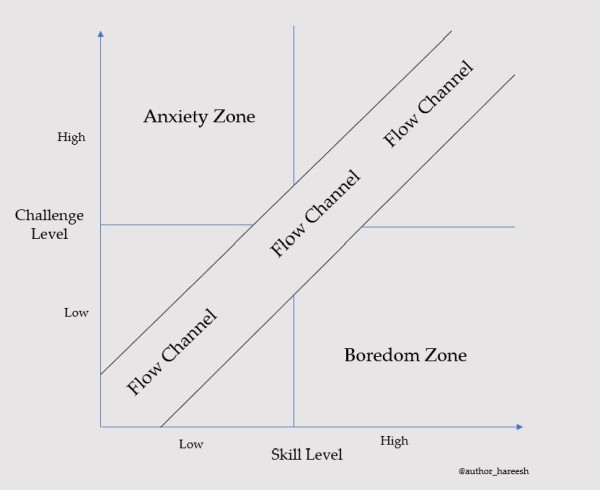Imagine you are asked to face Roger Federer on a tennis court. How much probability do you have to win the game? Or, for that matter, how long can you hold the rally?
In the same way, have you ever undertaken a project so big that makes you paralyzed just by the mere thought of it? Or, on the contrary, have you ever been assigned a task that was outright simple and not challenging enough that you felt so bored and out of enthusiasm?
Then, it is time that we understand the concept of 'Flow.'

What happens in the 'Flow’ state?
- You remain fully engrossed in the task at hand.
- Both the emotions - boredom, and anxiety - are not felt.
- You completely lose track of how time flies.
In the end, you find that a deep sense of satisfaction arising mainly out of the very work than out of the outcome. Flow state is a sweet spot.
How do we find the sweet spot every time?
Look at the diagram below.

The flow consists of two dimensions:
- The Challenge Dimension, and
- The Skill Dimension.
When you are about to take up a project, simply assess what is the challenge level of the project as a whole and what is your current skill level for the project.
Once the basic assessment is done, start deconstructing the big project into bite-sized chunks, and stack it progressively from easy to medium to hard level.
Then, jump right into the task. Start accomplishing smaller tasks first. With that, your skill level would increase a bit. Then get into a bit tougher task, and then into much tougher ones. And finally, after hundreds of iterations, there will come a situation where your skill level would be that of a master and you can face the 'Roger Federer' level of challenges too. This is the most blissful ladder to mastery in any field.
Applying 'Flow' to CA
Let us take the concept of Amalgamation, for example:
This was a chapter that had been a nightmare for me throughout my CA course. If you are a beginner, when you see amalgamation as a chapter overall, you are immediately bound to get into the Anxiety Zone. That is because the estimated level of Challenge of this chapter will be way higher than your estimated level of Skill.
It is at this time you spend time having a bird’s eye view of the chapter by skimming again and again at least 5 times. Allot a minimum of 30 minutes for this exercise. Well, I wouldn’t mind even if you allow 1 hour for this at the very beginning (trust me, this is going to save a lot of time and tension later).
Once you have had a sufficient bird’s eye view of the chapter, start to deconstruct the entire chapter into a progressive piece of chunks.
Ok so, what are all the things that you would see in the concept of amalgamation?
- Nature of amalgamation and the 5 conditions that determine it.
- Method of accounting.
- The concept of purchase consideration and the ways to compute it.
- Intrinsic Value method.
- Share payments method.
- Concept of Goodwill and Capital Reserve.
- Intercompany owings and their cancellation.
- Types of intercompany capital holdings.
- Adjustments when selling company holds shares in purchasing company.
- Adjustments when purchasing company holds shares in Selling company.
- Adjustments when there is a Cross holding.
- Getting hold of the Schedule III format.
- Mastering the journal entries under the books of both companies.
Both you and I are very well aware that we can further break the above outline down into many, minute chunks.
After segregating the chapter into multiple categories. if you still find a category difficult to your perception, your job is to further deconstruct it until the level you do not find it anymore beyond your control.
Your intention should be finding out what exactly in that chunk is making you feel it is difficult or beyond your understanding, and then deconstruct it further.
Process in any task could be always enjoyable when the level of challenge keeps on meeting the level of skill. As you can see in the image, if you could travel on the flow channel, every task becomes enjoyable. Flow is journey-oriented, and not outcome-oriented. The outcome is something that is arrived at automatically.
Article inspired and adapted from the book "Flow" by Mihaly Csikszentmihalyi.








 CAclubindia
CAclubindia

